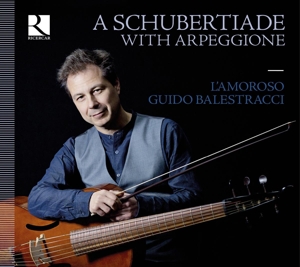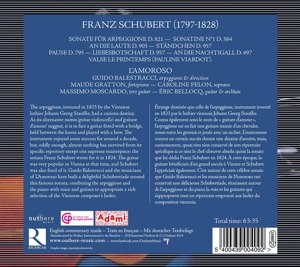€23.99
Op voorraad
A Schubertiade with ArpeggioneGuido Balestracci, l'Amoroso
Schubert, Franz Peter Xeraph (1797-1828)
Werk:
An die Nachtigall, D497 | Schubert: An die Laute D905 | Schubert: Die schöne Müllerin, D795, No.12 "Pause" | Schubert: Schwanengesang, D957 no.1 Liebesbotschaft (Rellstab) | Schubert: Schwanengesang, D957 no.4 Ständchen 'Leise flehen meine Lieder' (Rellstab) | Schubert: Sonata in A minor 'Arpeggione', D821 | traditional: Schöne Minka | Viardot-Garcia: Valse le printemps, VWV 1177
Vocalist:
Pelon, Caroline
Instrumentalist:
Balestracci, Guido | Bellocq, Éric | Gratton, Maude | Moscardo, Massimo
Ensemble:
Amoroso, L'
The arpeggione, invented in 1823 by the Viennese luthier Johann Georg Stauffer, had a curious destiny. As its alternative names ‘guitar violoncello’ and ‘guitare d’amour’ suggest, it is in fact a guitar fitted with a bridge, held between the knees like a cello and played with a bow. The instrument enjoyed some success for around a decade, but, oddly enough, almost nothing has survived from its specific repertory except one supreme masterpiece: the ‘Sonata’ Franz Schubert wrote for it in 1824. The guitar was very popular in Vienna at that time, and Schubert was also fond of it; the original version of ‘Die schöne Müllerin’ was published with guitar accompaniment! Guido Balestracci and the musicians of L’Amoroso have built a delightful Schubertiad around this famous sonata, combining the arpeggione and the piano with voice and guitars to appropriate a rich selection of the Viennese composer’s ‘Lieder’.






Beoordelingen
Er zijn nog geen beoordelingen.